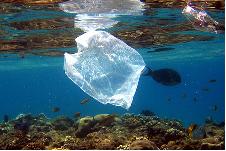Pacific Ocean plastics dump worse than researchers expected
 After sailing through thousands of miles of plastic-strewn waters, two ships returned to California late last month with new data from the planet’s largest garbage patch.
After sailing through thousands of miles of plastic-strewn waters, two ships returned to California late last month with new data from the planet’s largest garbage patch. The researchers with Project Kaisei, an expedition funded by scientists and international recycling companies, studied the North Pacific Gyre, an expanse of 10 million square miles between the equator and 50 degrees north latitude. A confluence of ocean currents directs an unusually large amount of man-made debris into the area, but little is known about the extent or nature of the pollution or how it might be cleaned up.
The monthlong mission turned up more trash than researchers expected.
At a recent news conference at South Beach Harbor here, the research team displayed fishing nets, plastic bottles and other debris collected 1,400 miles away.
Expedition co-founder Mary Crowley, who first sailed through the gyre 30 years ago, said she was stunned by the accumulation of plastic since then. Thirty years ago, she counted only a few fishing floats, a net, and two pieces of plastic debris over four days at sea. “There was nothing out there that at that moment seemed any signal for alarm,” she said.
This time, Crowley said, what she saw scared her.
“As we got into the gyre, some of our trawls found hardly anything but plastic,” she said. “We found even more than we expected.”
Using ocean-skimming devices called manta trawlers, the ships found between 25 and 400 pieces of debris per hour. In addition to plastic, the researchers found tiny jellyfish known as tinafores eating the smallest plastic pieces, which can contain toxic chemicals like DDT and PCBs. Researchers said it would not be long before the plastic ends up in people who eat the salmon that feed on the jellyfish.
“We are apex predators,” principal investigator Andrea Neal said. “We’re seeing it in killer whales, we’re seeing it in marine mammals, and it won’t be long before we’re seeing it in ourselves.”
Crowley said she was particularly thrown by the amount of particulate matter they found. “It’s the insidious, deadly, small pieces that really got me,” she said. “It’s impossible for me to think what the ocean will be like 30 years from now if we don’t make changes.”
More detailed results will take several months, researchers said. Assisted by scientists from California EPA and the Scripps Institute of Oceanography, Project Kaisei investigators will provide state and international policymakers with an idea of the challenges and opportunities the mess poses. “It’s the best picture of our human condition ever witnessed,” said project co-founder George Orbelian. “We don’t have to wonder anymore; all we have to do is look.”
Next steps
While scientists found more trash than they anticipated, they also held out hope for technology-based solutions.
Doug Woodring, another of the expedition’s founders, suggested switching to plant-based plastics and, in areas that do not have conventional recycling, turning plastics to fuel.
He stayed away from assigning blame for the mess. “It’s no one’s fault directly, but it’s time to create awareness and come up with solutions,” Woodring said. “I’m not just talking about a plastic bag tax,” a policy that San Francisco and several other cities have introduced.
In addition to funding from individual donors, Project Kaisei is backed by the Bureau of International Recycling, whose membership counts 77 companies from Austria, China, Cuba and Canada, to name just a few of the nations represented. Deutsche Bank AG is also a key funder.
John Chen, a vice president at BIR, said he saw financial promise in creating methods to clean up the trash. “If there are subsidies that would help, but the material already has value,” he said, adding that microscopic plastic particles are a particularly thorny problem.
“There are ingenious ways to think about doing cleanup,” Neal said. “There’s a lot of intelligence in humanity.”
For More Information: World Business Council - WBCSD
You can return to the main Market News page, or press the Back button on your browser.

